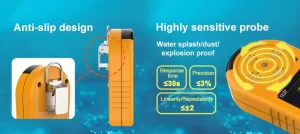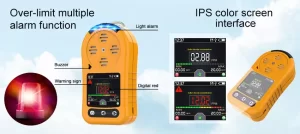Air pollution has become a global concern due to its detrimental effects on human health and the environment. As urbanization and industrial activities continue to grow, monitoring air quality becomes increasingly crucial. In recent years, advancements in gas sensor technology have revolutionized air quality monitoring by providing accurate and real-time data on pollutant levels. This article explores the benefits and applications of gas sensor technology in revolutionizing air quality monitoring.

Understanding Gas Sensor Technology:
Gas sensors are devices that detect and measure the concentration of various gases present in the air. They utilize different sensing technologies such as electrochemical, semiconductor, or optical methods to detect specific gases. Gas sensors operate based on the principle that when a target gas comes into contact with the sensing material, it produces a measurable signal indicative of its concentration. This technology enables the detection of multiple pollutants simultaneously and provides valuable insights into air quality conditions.
Real-Time Monitoring of Pollutants:
Traditional air quality monitoring methods involve periodic sampling and laboratory analysis, which often result in delayed results. Gas sensor technology allows for real-time monitoring of pollutants, providing instantaneous data on pollutant levels. This real-time monitoring capability enables prompt response and intervention when pollutant concentrations exceed acceptable limits. It helps regulatory agencies, urban planners, and policymakers make informed decisions to protect public health and mitigate the impact of air pollution.
Multi-Gas Detection:
Gas sensor technology offers the ability to detect and measure multiple gases simultaneously. Different sensors can be integrated into a single device, allowing for comprehensive air quality monitoring. This multi-gas detection capability enables the measurement of various pollutants, including nitrogen dioxide (NO2), ozone (O3), carbon monoxide (CO), sulfur dioxide (SO2), volatile organic compounds (VOCs), and particulate matter (PM2.5 and PM10). By monitoring multiple gases, gas sensors provide a comprehensive understanding of air pollution sources and their impact on human health and the environment.
Portable and Wireless Monitoring:
Advancements in gas sensor technology have led to the development of portable and wireless monitoring devices. These compact and lightweight sensors can be easily deployed in various locations, providing flexibility in air quality monitoring. Portable gas sensors enable real-time measurements in different environments, including indoor spaces, vehicles, and outdoor areas. Wireless connectivity allows continuous data transmission, remote monitoring, and integration with centralized air quality monitoring systems. This portability and wireless capability enhance the spatial coverage and accessibility of air quality monitoring, especially in urban areas with varying pollution levels.
Citizen Science Initiatives:
Gas sensor technology has facilitated the emergence of citizen science initiatives, empowering individuals to actively participate in air quality monitoring. Citizen scientists can utilize low-cost gas sensor devices to measure pollutant concentrations in their surroundings. By collecting and sharing data through online platforms or mobile applications, citizens contribute to a larger dataset, enhancing the overall understanding of air pollution patterns. Citizen science initiatives promote public awareness, engagement, and collaborative efforts in tackling air pollution issues at the community level.
Integration with Smart City Solutions:
Gas sensor technology plays a pivotal role in the development of smart city solutions for air quality management. By integrating gas sensors into existing infrastructure, such as lampposts or buildings, cities can create a network of interconnected sensors for continuous monitoring. This data-driven approach enables real-time analysis, predictive modeling, and decision-making based on air quality data. Smart city solutions leverage gas sensor technology to optimize urban planning, traffic management, and mitigation strategies, ultimately improving the overall air quality in cities.

Future Directions:
As gas sensor technology continues to evolve, there are several areas of focus for future advancements. Sensor accuracy, calibration, and long-term stability are essential factors for reliable and consistent measurements. Improved sensor miniaturization and energy efficiency will enable the development of smaller, more versatile sensor devices. Additionally, advancements in data analytics, machine learning, and artificial intelligence will enhance the interpretation and utilization of air quality data for effective pollution management strategies.
Conclusion:
Advancements in gas sensor technology have revolutionized air quality monitoring by providing accurate, real-time data on po
 : +86 155 8830 2704
: +86 155 8830 2704 : jxdziot@gmail.com
: jxdziot@gmail.com
